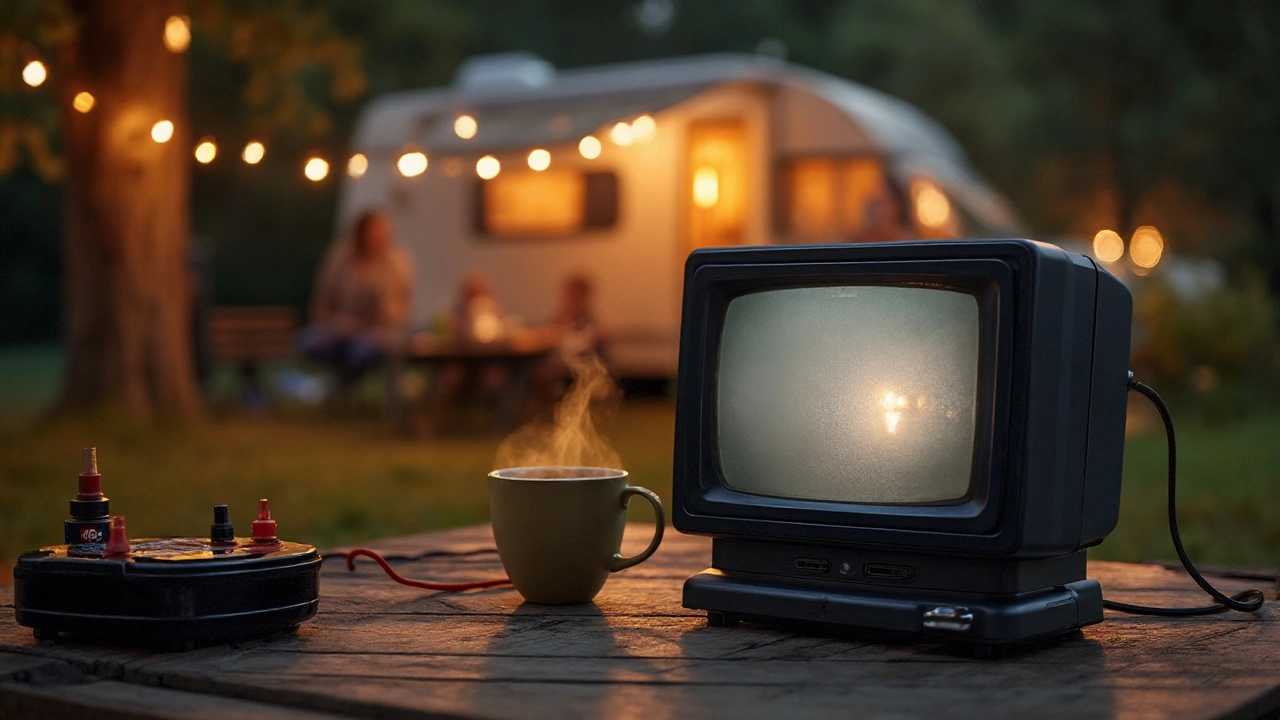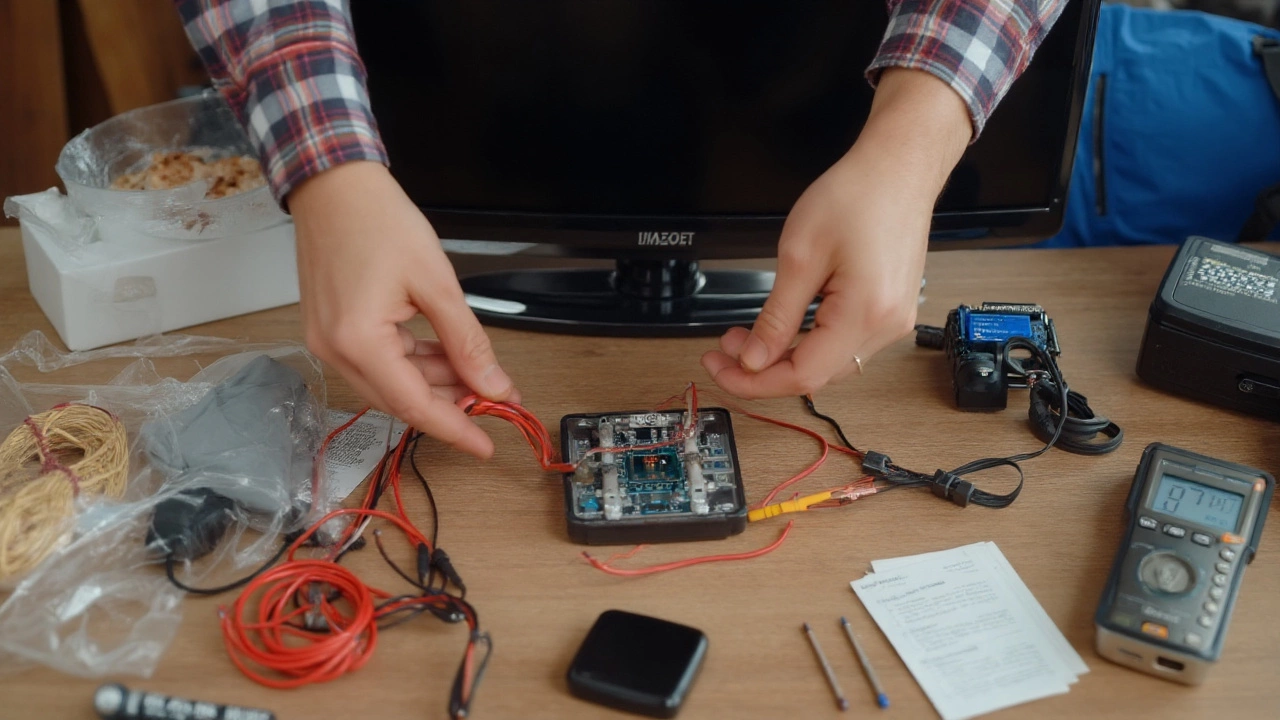Running a 12-Volt TV Off a Battery: Safe, Smart Power for Off-Grid Viewing
 Aug, 3 2025
Aug, 3 2025
Fire up your portable TV in the bush, and suddenly you’re the king (or queen) of camp comfort. It’s hard to beat a bit of Netflix, footy, or the nightly news after a day of exploring the great outdoors. But once you look past the appeal, a real question pops up—can you just hook your 12-volt TV up to a battery and expect everything to go smoothly? Lots of people try it, a few regret it, and some swear by it. This isn’t just about making stuff work—it’s about not wrecking your gear or draining your battery after one movie night. Let’s get into what’s safe, what you need to know, and how to stream off-grid without cutting your trip short.
How 12-Volt TVs Really Work With Batteries
Most compact TVs designed for campers or caravans are built to run on 12 volts. That means you’re in luck—they’re supposed to work with the same kind of battery you’d find in your car or caravan. But here’s the catch: not every 12-volt TV is made equal, and not every battery is up for the job. When you’re buying a 12-volt TV, the label means it’s happy to run off the same voltage as a standard lead-acid or lithium deep cycle battery. Sounds simple, right?
Here’s the science: a 12-volt battery isn’t always exactly 12 volts. When it’s fully charged, it can sit around 12.7V–13.2V. As it discharges, voltage drops and, near empty, it can fall below 12V. Cheap electronics hate this, good ones handle it. Reputable camping TV brands (think Englaon, Sphere, or RV Media) handle a slightly wide voltage range—often 10V to about 15V—because solar charging, fridges, and lights can make the voltage wobble. Plug in a home TV via an inverter, and it gets grumpy quickly or uses way more power than you thought because inverters aren’t magic—they waste some power just working. A purpose-built 12-volt TV runs efficiently and safely straight off a 12V battery.
Important note: just because your TV has a 12V adapter at home, don’t assume it’s camper-ready. Some have sensitive circuits that trip protection or fry if voltage isn’t perfect—so always check the manual or contact the manufacturer. You want a unit made for off-grid use, not just a household TV with a different power lead.
Some TVs also come with cigarette lighter plugs. If your camper, car, or caravan has a properly fused 12V socket, great! If you’re cobbling together something with crocodile clips and open wires—don’t. Loose connections can heat up, melt wires, or short out, and now you’ve got a much bigger problem.
What Size Battery Do You Need? Let’s Crunch the Numbers
How long you can binge-watch depends on how much power your TV slurps and the size (capacity) of your battery. Camp TVs usually draw 1–3 amps per hour (A/h) at 12V. If you’ve got a 22-inch LED TV pulling 2A, and you want to watch for four hours—that’s 2A x 4h = 8 amp-hours (Ah). If your battery is 100Ah, sounds like you’re golden, but it’s not quite that easy.
There’s a golden rule: never flatten a lead-acid battery below 50%. That 100Ah battery gives you a safe 50Ah for regular use, or you could wreck its lifespan. Lithium batteries let you use up to 90% of their capacity, which is wild, but they’ll cost you more upfront.
If your campsite TV session will burn 8Ah, and you’re running it off a 100Ah deep-cycle lead-acid battery, you could manage six TV sessions before it gets risky low. But you likely have lights, a fridge, or USB chargers running too. Want to see those numbers laid out? Here’s a quick comparison:
| TV Power Draw | Hours Use | Battery Type | Battery Size | Safe Usable Power | TV Sessions |
|---|---|---|---|---|---|
| 2A | 4 h | Lead-acid | 100 Ah | 50 Ah | 6 |
| 2A | 4 h | Lithium | 100 Ah | 90 Ah | 11 |
Then, throw in a portable solar panel and you can recharge during the day, stretching your battery and your TV time—no generator needed. Consider your whole setup: are you parked under gum trees or in the open with sun all day? That changes things.
12-volt TV power setup isn’t just guesswork—jot down what hours you’ll actually watch and what else is running. Add a safety margin, because real-life usage is never perfect—kids mess with settings, someone leaves the TV on during their nap, and so on. Where possible, use lithium batteries for longer runtimes and a happier camping experience.

Wiring Up Right: Safety First, Then Simplicity
Some blokes get a little too casual with 12V gear. Your battery is a serious chunk of power, and TVs (and other electronics) aren’t cheap. A few key things keep you safe and your gear humming:
- Fuse it! Always use a fuse as close as possible to the battery’s positive terminal. Check your TV’s manual for its recommended rating—if it says 3A, stick close to that.
- Use thick, quality wire. Too-thin cable means voltage drop or melting insulation. For most portable TVs, 1–1.5mm² is fine for a short cable, but go heavier for longer runs.
- Keep connections tight. Use proper crimp or soldered terminals. No tape-twisted messes.
- Keep it dry. Dampness is wrecked-circuit territory. Route cables away from wet spots and check your TV’s IP rating if you’re watching outside.
- If using a cigarette plug adaptor, make sure it’s not a dodgy $3 eBay special. Loose plugs get hot fast.
Handy tip: Consider adding a voltmeter to your setup to keep an eye on battery voltage. If you drop below 12V with lead-acid, it’s time to lay off the telly—or risk getting stuck with a flat battery come morning. Lithium’s safe lower range is a bit lower, but check your battery’s specs.
If you’re running things from your vehicle battery, be aware: deep cycling a starter battery reduces its life fast and might leave you stranded. Always better to use a separate deep-cycle or lithium chemistry that’s designed to handle regular discharge and recharge cycles.
Smart Tips for Making the Most of Off-Grid TV
If you’re serious about stretching your off-grid TV experience, there are a few clever tricks to keep in mind:
- Drop your TV’s brightness and screen backlighting. At night, it barely matters, and it reduces power draw by up to 30%.
- Switch off when not in use—even short breaks. Screen savers still use energy.
- Run speakers at a sensible volume. Louder isn’t just about disturbing the wallabies; it uses more juice, especially on high-powered TVs.
- Use a modern LED TV. They’re far more efficient than old plasma or CRT screens, which aren’t really designed for camping anyway.
- Invest in a quality MPPT solar controller for your panels—more efficient charging means more free power to burn.
- Get a TV with built-in low-voltage cutoff. It’ll shut off before it can flatten your battery and leave you in the dark.
- If you use streaming devices (Fire Stick, Chromecast, etc.), power them off your TV’s USB, which is usually more efficient than a separate adapter.
- For longer trips, consider a portable lithium jump starter as a last-resort back-up power source—super handy if you overdo it on movie night.
If all else fails, good old-fashioned board games don’t need a battery. But for those moments when TV’s a must, getting the tech right means more time chilling and less time worrying about flat batteries.
So yes, you really can run a 12-volt TV straight off a battery—and with a smart setup, you can make it last. Don’t skimp on good kit, check your numbers, and you’ll keep the home comforts going long after sunset on your next campout.